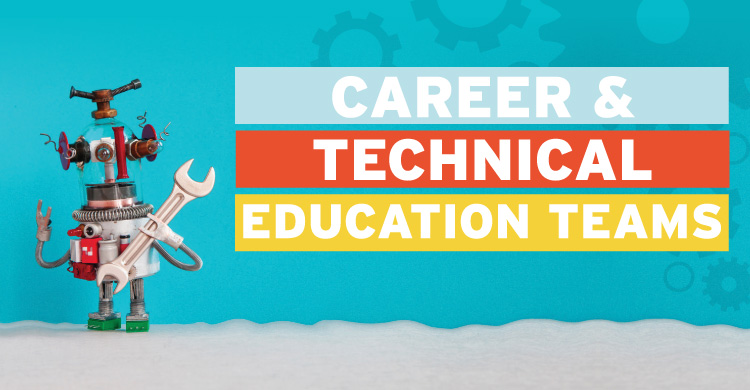Based on Collaboration for Career & Technical Education
“CTE” and “PLC” are six letters we don’t often see together.
Career and technical education teachers, authentically working interdependently within teams, has not become a common practice in most schools yet. This is not because CTE teachers do not want to work within collaborative teams—we do! We want to share curricula and reflect on data with colleagues. In most cases, we just don’t know how to establish teams that have a clear common purpose.
In our recently published book, Collaboration for Career & Technical Education: Teamwork Beyond the Core Content Areas in a PLC at Work, our goal was to provide a practical approach to engage CTE educators and others who may be “singletons” in the PLC processes. Here, we provide three steps to get you started this summer.
Step 1: Form Your Collaborative Team
Think about the teachers in your school who need a team. In most cases, these teachers are CTE instructors and others who teach singleton courses. Group these teachers by the “like-kind” courses that they teach. These teams might need to be reevaluated and reorganized once the teacher engages in the next step of identifying common denominators.
Depending on the intended student learning outcomes of the CTE team, any of the following team options can provide the structure needed for purposeful collaboration (DuFour et al., 2016; Hansen, 2015).
- Vertical team: Introduction to Food and Nutrition; Food Preparation; Culinary Arts 1 and Culinary Arts 2 teachers
- Interdisciplinary team: Agriculture; Business Education; Technology Education; Family and Consumer Sciences teachers
- Singletons who support teams: CTE and core subject area teachers
- Virtual team: A country or region’s automotive service teachers
- Blended team: Courses within a similar career cluster or pathway
Draft and agree on team member expectations, such as meeting norms, the locations of meetings, and members’ roles during team meetings. Roles in collaborative meetings often include a facilitator, note taker, meeting pacer, materials clerk, team leader, and other roles that may be specific to your team’s unique needs.
Establish a meeting schedule as far in advance as possible, and clarify expected outcomes of those meetings. Consider a cycle of events for your team, such as identifying essential skills, creating assessment questions, reflecting on student learning data, and deciding how students will get needed support.
Step 2: Identify Your Common Denominators
Once you form your collaborative team, your next step is to establish a clear purpose for your team. As CTE teachers, many of us have experienced the frustration of not knowing why we have been assigned to a particular team, what our role is supposed to be on that team, or why the team exists at all.
Typically, we have different roles or curricular content than the other members of the team. To address this hurdle in becoming a collaborative team, we suggest that you spend quality time identifying your common denominators. These common denominators will vary based on the makeup of teams. Consider the following categories to identify your team’s common denominators.
Career-Specific Standards are probably the easiest common denominators to identify. However, it may require identifying a common career pathway within your team membership, such as transportation or construction trades. In both pathways, there are several overlapping career-specific standards that could serve as common denominators. We recommend that you reference your career-specific professional organizations to support this work.
Broad Transferable Skills can be applicable for multiple programs of study and other courses. These skills focus less on career-specific standards and more on the skills necessary to be successful in college and career. Examples of transferable skills are communication, presentation, collaboration, and critical thinking.
Core Academic Skills: Regardless of identifying common denominators of standards or skills, it is important to help students see the connections of learning between their CTE courses and their core academics. This can be a challenge for students if CTE teachers have not considered alignment on standards and skills with the core academics before now. The CTE curriculum is laced with core academic connections. A few examples include these connections.
- Mathematics: Labor rates, measurements, and budgets
- Writing: Marketing, letters of interest, sales, letters of application
- Science: Developing and using models, experimentations
To support your team’s work in identifying common denominators, try this quick and simple collaborative protocol.
- Establish conversation norms.
- Assign a facilitator, recorder, and timekeeper.
- Instruct team members to individually write down all the skills they expect students to learn in the courses they teach during a given timeframe. (To save time, this step could be completed before the meeting.)
- Allow teachers to read the skills from their lists in round-robin fashion. Have the recorder write the skills on large paper or a whiteboard for everyone to view.
- Identify themes as a team.
- Agree as a team on one or more skills on which they will focus their collaborative work.
Step 3: Take Action
We are confident that we are at a point in our educational history to boldly state that teachers working within a collaborative team is the best form of job-embedded professional development—even for CTE teachers.
However, in most schools, the work of CTE teams is stalled. By establishing a team structure and identifying your common denominators that provide purpose to your collaborative work, you will be ready to take action.
As Robert Eaker wrote in his most recent book, A Summing Up, being action-oriented is “creating a culture that reflect(s) a willingness to experiment, develop, and test new hypotheses” (p. 139). One tool that we adapted from the 2016 edition of Learning by Doing by DuFour, DuFour, Eaker, Many, and Mattos, to support the work of CTE teams to be action-oriented, is a Team Strengths and Growth Survey.
This survey will help your team identify the key elements you should address for collaboration, curriculum, assessment and intervention. We hope that this survey, along with the steps provided, will give you the tools and confidence you need to get started or restarted in taking action to become an authentically interdependent collaborative CTE team.
Wendy Custable is the director of applied arts at the award-winning Adlai E. Stevenson High School in Lincolnshire, Illinois. She has been in education for 20 years, beginning her career as a technology education teacher.
[author_bio id=”313″]








Pretty Cool!!